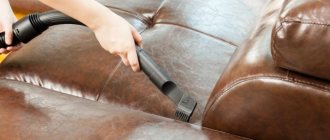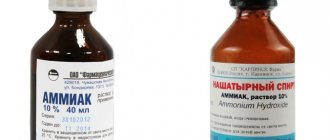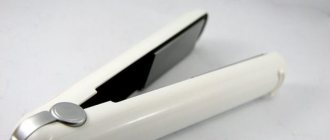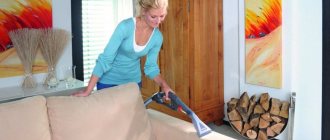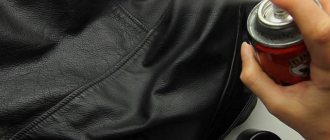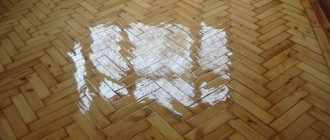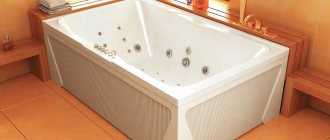Caring for chipboard furniture: you can’t wash it with soda... But what can you do with it?
Today we explain how to properly care for furniture made from chipboard and laminated chipboard. Walls, chests of drawers, cabinets and even kitchen furniture are made from this material. Proper care will help prolong the initially beautiful appearance of the furniture set, and at the same time significantly simplify the cleaning process. And at the same time, you will stop buying products that can ruin the surface or age the furniture faster. Let's learn how to save correctly!
We admit that many of you, dear experienced housewives, are already familiar with these secrets. However, we receive questions about how to properly care for chipboard furniture, and we decided to cover them in a separate publication.
1.
Slightly damp soft suede, flannel or microfiber napkins are the best cleaning assistants.
The surface of chipboard and laminated chipboard is afraid of high humidity. With constant exposure to moisture, the slab “swells” and warps. If the edges of the furniture have come off or chips have appeared as a result of mechanical impact, you should wash the surface of the stove with great care.
In case of severe contamination of the surface, it is permissible to wash the facades and shelves with a light soap solution and immediately (!) wipe them with a soft cloth, without leaving the water to dry on its own. When you just need to wipe off dust, use a slightly damp cloth.
2.
Household chemicals are suitable, but only special ones, without abrasive particles.
“Polish” for furniture and other analogues will help remove not only dust, but also traces of pencils and pens, sometimes with their help you can even remove felt-tip pen stains and brilliant paint! The advantage of “Polish” is that the spray gives the facade an antistatic effect, furniture attracts dust less. This means you can clean a little less often.
BUT! Please note that the “Polish” is not intended for natural wood! This product contains wax and therefore can warp the protective film on the chipboard or ruin its color - this is exactly what we are trying to avoid.
3.
Window cleaners are excellent for caring for chipboard furniture.
The same “Mr. Muscle” or its analogues paired with a soft cloth are ready to work wonders: you will see how easily all stains are wiped off. And you don’t even have to forcefully scrub the facades, spending a whole day of hard work on it.
But what you shouldn’t do is:
→ Use a scraper and sponges with a hard base,
→ Wash furniture with hot water,
→ Use vinegar, lemon juice and other acids,
→ Use heavy artillery in the form of abrasive cleaning agents. Including soda, no matter how much you read about miraculously getting rid of greasy stains with its help.
In fact, everything is not that difficult. We wish you that the furniture in your home retains its “store-bought” appearance for as long as possible.
Source
Dream furniture Beds that don't break
Good housewives never forget to take care of their spacious closets and favorite chests of drawers. Caring for unpolished furniture is not at all difficult - it is only important to remember that when dealing with an unvarnished wooden surface, you cannot use oil products. This will protect your furniture from greasy stains. And never use products intended for polished furniture - they will leave greasy stains on the wood that will not be easy to remove.
Rules of care
Of course, unpolished wood is good - it looks natural and aesthetically pleasing, but, alas, it is very susceptible to all kinds of dirt. Ideally, caring for unpolished furniture should be done daily. It is advisable to vacuum the unpolished surface using a soft-bristled attachment. This will rid the wood surface of dust accumulations, which, penetrating into the smallest cracks, give the furniture an ugly grayish tint - dull and untidy. If the moment was missed and the furniture still became dirty, wipe it first with a damp and then with a dry cloth. Wipe off heavy stains with soapy water, quickly removing any traces of it with a clean, dry cloth.
Caring for unpolished light-colored furniture: • melt a white wax candle in a water bath; • mix wax with gasoline/white spirit (1:1); • apply the cooled mixture to the furniture (for 2-3 hours); • polish with a flannel cloth.
Restoring old furniture
If unpolished furniture is not properly cared for, it has every chance of losing its original attractiveness and becoming unpresentable and neglected. To refresh old furniture, follow the steps below:
• Take a damp cloth and wipe off the dirt thoroughly. • Wipe the furniture with a dry cloth, carefully removing moisture. • Make a composition. Place the finely chopped wax in a bottle, fill it with turpentine, seal it and put it in hot water. When the wax melts, shake the bottle so that the composition becomes homogeneous. • Apply the prepared composition to unpolished wood - use a brush or cotton swab. After a day, vigorously treat the wood with a cloth or piece of woolen cloth.
How to remove grease stains?
One of the most troublesome parts of caring for unpolished furniture is fighting stains. It is not easy to remove greasy stains from unpolished wood; usually, a mixture of alcohol and drying oil (1:1) is used. The composition is applied with a flannel swab. Then rub the contaminated area until the stain disappears. After drying, polish the wood with flannel.
How to remove blisters and dents?
If, while caring for unpolished furniture, you find a dent, do not be alarmed. To eliminate them, it is enough to carry out a simple “turpentine” rehabilitation: • wipe the dent with turpentine; • place wet gauze, folded in four, over the dent, and a metal bottle cap (smooth side down) on top of it; • press down the stopper with a hot iron.
Blisters, which often occur due to high humidity, are removed as follows: • Small blisters are ironed with a heated iron through paper folded in several layers. • Large swellings are pierced with an awl and furniture glue is injected into the hole - for this you can take an insulin syringe. Place paper on top and iron it. Pressing the swollen area with a weight, leave it for 2-3 days.
More details
Read also
Furniture
Furniture Furniture changed (and is changing) slowly, but some of its objects died out, others changed, and still others changed their names. For example, BUREAU is an intricately configured desk with desk drawers and many compartments for storing papers and small items.
Furniture
Furniture The demand of collectors for antique furniture has stirred up dealers in skillful plagiarisms. It is possible to protect yourself from unwanted counterfeits only if the collector himself carefully studies all aspects of old furniture: its shape, decor, production history,
Furniture: upholstered furniture, polished, leather, uncoated
Furniture: upholstered furniture, polished, leather, uncoated Caring for upholstered furniture Upholstered furniture requires no less careful care than carpets and rugs. In order to remove dust from it, you must first vacuum it. But that's not all. If you want her to become
Polished furniture
Polished furniture Polished furniture should never be wiped with a damp cloth. First, you need to remove dust from it using a piece of flannel or cloth, and then with a cloth lightly moistened with “Polish” liquid or some other care product.
Main problems with lacquered furniture
Such home furnishings acquire their characteristic shine due to the fact that during the production process the wood is coated with special compounds containing resins and varnishes.
Due to these features, furniture:
- quickly absorbs various contaminants;
- prone to the formation of microcracks and chips;
- accumulates static electricity, which attracts dust.
Polished furniture has strict maintenance requirements. Such items should not be placed in rooms with high humidity levels or in places exposed to direct sunlight.
Lacquered surfaces do not tolerate temperature changes and exposure to abrasive particles. In both cases, cracks appear.
After cleaning the varnished surface with a damp cloth, stains remain, and the dry material electrifies the material, thereby facilitating the settling of dust.
TOP 7 best furniture polishes: how to choose, features of use, reviews
The appearance of furniture changes under the influence of many factors. Excessive dryness in the room, excess dust, exposure to ultraviolet rays and much more negatively affects the condition of surfaces. In addition, any, even minor, human impacts on furniture can lead to deterioration in external performance. But you can avoid damage, and you can easily return the furniture to its original attractive appearance. To do this you will need a good quality polish.
We have compiled a rating that includes products of different levels of impact. Among them are liquid, aerosol and cleaning polishes. Check out the TOP and choose the ideal option that suits your furniture. We wish you pleasant reading and happy shopping in the future!
The best liquid polishes for furniture
The TOP of the best liquid polishes includes products from the following brands:
Next, we will dwell in more detail on the description of each product and list their advantages and disadvantages, rules of use and some precautions.
HG Marble Polish
A special polish designed for marble products and surfaces. A thin protective film forms on objects, thanks to which the surfaces do not soon become dusty and dirty. The composition gives surfaces an unsurpassed shine, has no pronounced odor, and is applied in small quantities. To apply the composition correctly, you need to prepare the surface, clean it thoroughly, and then rub in the polish with little physical effort. In addition to marble, other natural stone surfaces are also processed. Follow the instructions!
| Result of use | shiny natural stone surfaces |
| Packaging, ml | 300 |
| Production | Holland |
Price: about 663 rubles.
pros
- no pungent odor;
- no streaks or marks;
- carefully works on stone surfaces;
- a protective film is formed;
- antistatic effect.
Minuses
- rubs with great difficulty, requiring effort.
The polish is good, but there are many subtleties in application. If done incorrectly, stripes and stains will remain. In general, I applied it incorrectly the first time, but the second time I repeated the procedure, taking into account all the requirements. The result turned out good, I'm pleased. No other product has worked with natural stone before.
Pronto with lemon flavor
One of the popular and affordable furniture care products. The product contains silicone, thanks to which in a short time you will hide any imperfections in the furniture, renew it and give the items their original appearance. As a result, the surface shines. The consistency of the product is convenient - not liquid, but more like a cream, conveniently distributed over the surface. You only need a small amount of cream and it rubs in easily and quickly. You will smell a light lemon aroma for some time.
| Volume, ml | 300 |
| A country | Ukraine |
| Effect | gently polishes furniture, restores the natural beauty of wooden objects, removes fingerprints and other stains |
Price: from 99 to 136 rubles.
pros
- polishing of wooden products;
- special composition with a minimum content of surfactants;
- pleasant aroma;
- creamy consistency;
- cleans and polishes furniture;
- no divorces;
- hides flaws;
- Suitable for different types of materials and surfaces.
Minuses
- It takes a lot of product and gets used up quickly.
Good product! There is a lot of wooden furniture in the house; polish cleans it perfectly. The dust does not appear soon, but there is a pleasant aroma. I recommend it to anyone who cares about the cleanliness of their furniture and wants to return it to its original well-groomed appearance.
"Cinderella"
A fairly budget-friendly product that contains an active waxy substance. Thanks to wax, a special protective moisture-repellent film is created on the surface of the furniture, which also does not allow dust to settle on the product. Your surfaces remain clean for a long time; no streaks or greasy stains remain on the furniture. By the way, it is worth noting the light lemon aroma; it persists for several hours, after which it quickly dissipates. The lid is screwed on and has a special hole in it. Through it, the product is squeezed out in a certain amount. The consumption is economical, and this is its great advantage.
| Manufacturer | Russia |
| Package volume, ml | 250 |
| Effect of use | gentle cleaning of surfaces, polishing damage and scratches, antistatic effect, pleasant aroma |
Price: from 35 to 69 rubles.
pros
- antistatic agent;
- economical consumption;
- absorbs quickly without leaving marks or streaks;
- availability for purchase;
- light lemon aroma;
- ease of use.
Minuses
- Doesn't remove all contaminants.
Cinderella once saved old furniture. We transported it to the dacha, some surfaces were scratched, and there was plenty of dirt. We prepared the surfaces in advance and applied the product effortlessly. The furniture began to shine again, as if it had just been bought. Of course, I won’t say that the consumption is economical, as the manufacturer himself writes about it, but it is enough for a large number of surfaces - that’s a fact. And the effect is excellent, I still recommend it.
Mold
Proper care of wooden furniture will not lead to problems such as mold.
However, if it is in a very damp room or outdoors, this misfortune cannot be avoided, but you can fight it if you take care of things from the beginning.
How to clean wood from mold:
- Pour vinegar into a spray bottle and use against fungus. Spray it on the desired areas, brush the wood, then spray the problem areas again and leave for an hour. There is no need to rinse, when the vinegar has evaporated, walk over the surface with a dry cloth.
- Treat areas affected by mold with hydrogen peroxide. Do not use it on dark surfaces. Peroxide brightens. After 10 minutes, walk over the surface with a soft brush, removing all traces of the fungus.
- Use tea tree oil. Add 5-6 drops to 200 ml of water and wipe all surfaces overgrown with mold with this mixture.
- Pine oil also copes well with fungus, and also smells nice. Dilute 1 tsp in a spray bottle. products with 1 tbsp. l. water, spray onto problem areas and leave to soak.
To prevent wooden furniture from becoming moldy, you need to take proper care of it. She needs good ventilation.
The best aerosol polishes for furniture
Aerosol polishes are quite practical and have economical consumption. In addition, they are easier to apply to certain areas. The best aerosol furniture polishes:
Chirton “Anti-dust”
The polish is sold in a convenient aerosol bottle and has a distinct marine aroma. It copes with fingerprints and dirt, but practically does not fight stubborn stains. The composition includes a mixture of silicones, they create a protective thin film on the surface, protecting it from scratches, external influences and damage. Processing does not require much effort from the user, the surfaces shine with cleanliness and freshness. The advantage of the product is its versatility. The polish is suitable for wooden and chrome-plated products, ceramic, marble, plastic, and enameled materials.
| Volume, ml | 300 |
| A country | Russia |
| Effect | universal care for different types of surfaces, protection from dust and moisture |
Price: from 109 to 129 rubles.
pros
- protective film;
- availability for purchase;
- removes minor dirt;
- universal product for different materials;
- does not cause an allergic reaction.
Minuses
- plaque on light-colored surfaces;
- The spray gun fails quite quickly.
The sprinkler is the main problem of the product. It is good in everything, but the spray bottle breaks and is almost impossible to use. If the manufacturer offers a product without an aerosol, then I will continue to use it. But for now this is a minus because of this, although the efficiency is really at a high level, I have no complaints about the quality.
Gallus
The product from a well-known German manufacturer is suitable for various types of surfaces, including laminated, wooden and varnished. It has pronounced water-repellent properties, disinfects surfaces, removing all visible dirt. There are no dyes in the composition, so the product is suitable for both dark and light surfaces and furniture of different shades. The polish removes small spots and the surface looks like new after treatment. In addition, the product forms the thinnest film, there are no streaks or greasy stains. The polish is suitable for regular use. A convenient sprayer allows for spot treatment of surfaces.
Cleaning complex contaminants
Folk remedies also help to cope with difficult stains. In particular, to clean surfaces, you can sprinkle problem areas with flour and then wipe with vegetable oil.
Traces from hot dishes
To remove such marks, just put a small amount of salt in a cloth, roll up the bag and wipe the furniture. Then the surface must be treated with vegetable oil.
Wax drops
To get rid of the wax, you need to heat the knife and pry out the drops. After this, the problem area is rubbed with gasoline.
Ink stains
A mixture of beer and wax helps get rid of ink stains. This composition does not need to be boiled first. After treating stains, the mixture should be immediately washed off with water.
Heavy soiling
Heated 9% vinegar can remove such stains. You need to moisten a cotton swab in this liquid and then wipe the problem area.
Cleaning away traces of flies
White wine helps with such traces without adding other ingredients.
Unknown origin
To remove any stains, you can use vegetable oil, which should be mixed with ethyl alcohol.
Fat
Traces of fat can be easily removed with leftover tea leaves wrapped in cotton cloth.
The best cleaning polishes for furniture
Furniture should not be cleaned with chemical solvents or alkali. Manufacturers offer a wide range of beneficial products with a polish effect, which also effectively clean products from dirt and do not harm them:
Premium House
The product is designed to perform different types of cleaning. This multifunctional liquid easily returns a presentable appearance to wooden products and cleans them of various types of contaminants. After treatment with the product, a thin protective layer remains on the surfaces; it allows you to extend the life of wooden products and prevents the wood from drying out. It has an antistatic effect, so you will forget about dust for a while. In addition, the 500 ml package will last for a long time; the lid has a convenient dispenser spout.
| Manufacturer | Russia |
| Package volume, ml | 500 |
| Effect of use | well-maintained and updated wooden surfaces |
Price: from 179 to 200 rubles.
pros
- Absolutely clean furniture without streaks or marks;
- Suitable mainly for wooden products;
- has no unpleasant odor;
- the dispenser spout gives the required amount of product;
- antistatic effect, less dust;
- availability for purchase in stores.
Minuses
- not suitable for metal products.
The best wood care product, but you'll have to figure out how best to use it. I leave a little product on the surface for about 7 minutes, after which I wipe particularly dirty areas. Convenient packaging, you don’t have to worry about running out quickly. As a rule, very little money is required. Read the instructions and remember that this product damages metal, so limit yourself to wood processing.
Nihon Detergent
Spray foam perfectly cleans surfaces and is suitable for different types of surfaces. Cares for furniture, electrical appliances, removes sticky and greasy stains. Polish makes surfaces smooth, restoring their lost purity and freshness. In addition, the product does not have an unpleasant odor, and only a small amount of spray is required to use. The packaging is convenient, with a spray bottle, foam splashes do not fly in different directions. You can independently determine the amount of product required without overspending.
| Volume, ml | 400 |
| A country | Japan |
| Effect | polishing and cleaning surfaces from various levels of dirt |
Price: about 350 rubles.
pros
- universal for different surfaces;
- cleans stubborn and fresh stains;
- gives surfaces shine for a long time;
- convenient and reliable sprayer;
- economical consumption;
- no pungent aroma, light lemon freshness.
Minuses
Despite the fact that the manufacturer claims slow consumption, my package ran out quickly. I’ll chalk this up to the fact that I treated a lot of different surfaces, since I haven’t done any cleaning for a long time. In general, I was completely satisfied with the effect, the only thing that bothered me was that I had to rub the polish in with force (sometimes I had to ask my husband to help me), but otherwise I am completely satisfied.
How to remove polish from old furniture at home. How to remove polish from furniture
Quite often you have to remove the polishing: it is not the most fashionable finish. Modern furniture is most often painted with opaque or tinted paints, and the surface is matte. In any case, the polish must be removed. There are several ways. Since varnishes come in different compositions, you have to select them experimentally. But one of the methods should work.
- You can remove old polish from furniture mechanically. If you have a sander, the process will go faster; if not, take coarse-grain sandpaper and remove the varnish layer until wood appears. Then take a fine grit and sand it to a smooth surface. Mechanical removal does not always work. Sometimes even a grinder does not give results: the polish does not come off, but begins to melt and stink. Then they change tactics.
- You will need a piece of old glass. Put on gloves and break it into several fragments. Use the sharp edges that have formed to scrape the coating down to the wood. If there are chamfers and recesses, it is convenient to scrape them out with sharp edges. After the main layer of polishing is removed, everything is brought to a smooth state using fine-grain sandpaper.
Often, restoring furniture with your own hands requires tough measures: some types of polishing can only be scraped off with glass
- If working with glass does not appeal to you, chemical methods remain. There are ready-made products for removing polish. You can work with them either in the open air or in a draft: the fumes are harmful. How to remove polish - you need to read on the packaging. The means are different and the duration and order of processing may vary.
Comparison table of characteristics
The table below presents the main characteristics of the brands in question. Compare them with each other and choose the polish that best suits your needs.
| The product's name | Variety | Volume, ml | Effect |
| HG Marble Polish | liquid | 300 | shiny natural stone surfaces |
| Pronto with lemon flavor | liquid | 300 | gently polishes furniture, restores the natural beauty of wooden objects, removes fingerprints and other stains |
| "Cinderella" | liquid | 250 | gentle cleaning of surfaces, polishing damage and scratches, antistatic effect, pleasant aroma |
| Chirton “Anti-dust” | aerosol | 300 | universal care for different types of surfaces, protection from dust and moisture |
| Gallus | aerosol | 750 | protective film, shine, no coloring elements |
| Premium House | cleaning | 500 | well-maintained and updated wooden surfaces |
| Nihon Detergent | cleaning | 400 | polishing and cleaning surfaces from various levels of dirt |
Daily care
It should be remembered that the surface of unpolished furniture is much more susceptible to dirt, since it is not protected by a layer of furniture varnish. Therefore, it must be cleaned regularly, ideally daily, with a vacuum cleaner with a soft bristle attachment. This will help avoid the accumulation of dust, which gets into the smallest cracks of the wood and gives the furniture an untidy grayish tint.
If contamination cannot be avoided, wipe the surface with a damp soft cloth and then wipe dry. Heavy stains can be wiped with soapy water and the remaining residue can be removed immediately with a dry, clean cloth. Products for polished furniture should not be used, as they will leave greasy stains that are difficult to remove on the wooden surface.
Instructions for use
To polish furniture with high quality, you need to:
- First prepare the surfaces. Clean them from dust and wipe them dry.
- Apply polish only to dry and clean surfaces using a soft cloth.
- If you have polish in an aerosol, then spray it at a distance of at least 30 centimeters from the surface.
- Squeeze the product in the form of a gel onto a sponge and begin treating the furniture.
- Using a little force will help the polish bond better with the surface and give you long-lasting results.
How to clean polished furniture from tape. How to remove tape from furniture
You use adhesive tape when transporting furniture - you “fix” the doors of cupboards, cabinets and bedside tables with it. This ribbon is very reliable and usually does not fail. But when the furniture has already been transported, an unpleasant surprise awaits you. Suddenly it turns out that it’s not at all easy to wipe the sticky miracle off your nightstands. And even if it succeeds, you will still have to suffer with the remaining sticky spot. So how can you remove tape from furniture without leaving any traces? Now you'll find out.
Gasoline for lighters
Regular lighter fluid is a great way to get rid of sticky tape:
- Just take a piece of cloth and soak it generously in lighter fluid.
Walk through the “remains” of the tape.
Rinse the vacated area with warm water.
Wipe dry and that's it.
But we warn you: the stink will still be there, so the method is effective, but not without flaws.
!Very important! Use gasoline very carefully, especially with polished and varnished surfaces. If you leave the “fuel” on them for too long, it will become so ingrained that you can’t remove it later. Well, perhaps together with polishing.
White spirit solvent glue also works well to remove tape. The removal method is the same as with lighter gasoline.
Another useful article: How to clean a samovar
Eraser
The eraser not only erases various pencil smudges - it can also clean the places where you had to glue the tape without any problems. Do it in this way:
- Take an eraser and hit the remains of the sticky miracle until you turn blue.
Then “polish” with a dry cloth, and that’s the end of it.
The method is excellent, but quite long - you just need angelic patience to completely remove the Velcro.
It will also be useful: Caring for an acrylic bathtub: 7 basic rules
Sunflower or olive oil
The oil perfectly removes stickiness from polished and painted surfaces:
- Dampen a clean cloth with oil.
Rub the sticky spot thoroughly.
Do not touch for 20 minutes until the sticky spot gets plenty of oil and begins to break down.
Rinse with polish and clean with a spatula.
Wipe with something dry (a paper towel will do) and say a long-awaited goodbye to the sticky miracle.
The disadvantages of this method are the same stink. Plus, if the surface is untreated wood, it is dangerous to rub oil on it - greasy stains may remain.
You can also wash away sticky marks with essential oil, which is sold in any pharmacy. But even after it the smell remains. True, it is much more pleasant than the aroma of sunflower, which will please only fetishists of this plant.
Another useful article: How to get rid of the smell of diesel fuel on clothes
Soda
To remove sticky stains from furniture, regular soda is enough:
- Prepare baking soda and dilute it in water to form a paste that looks like sour cream.
Apply “sour cream” to a sponge and rub it over the sticky spots.
Rinse and dry.
Another interesting article: How to remove a handle from a leather sofa
Hairdryer - for furniture plastic
Scotch tape can remain embedded in plastic almost forever. It's all because of the sun's rays - they literally “crown” the adhesive substance with the plastic surfaces, making them one, making it almost impossible to wash off the stains. But there is salvation and its name is a hair dryer. Yes, yes, the same one you use to dry your hair after a shower or shower. Just:
- Warm up the sticky spots with a hairdryer (to soften them, hot air is best).
Then introduce a tampon soaked in the same vegetable oil into the game. Rub it thoroughly onto heated sticky spots.
Remove the oil with soap and that's it.
Important! Furniture plastic does not always cope well with the attack of hot air vapors. If it is not of very high quality, yellow, difficult-to-remove stains and even deformations may appear. To hide them, you will again have to glue something on top: film, wallpaper... well, what is not decor in general?
You may also find it useful: How to clean brass at home
Tooth powder - for chipboard furniture
You won’t have to worry too much about tape stuck to chipboard furniture. Regular tooth powder and shaving foam (or any half-decent dishwashing detergent) will suffice:
- Mix tooth powder with foam.
Apply with a sponge to the remaining tape.
Wait (literally a couple of minutes) until the adhesive stain begins to liquefy.
Take a damp sponge and carefully remove the liquefied glue without pressing hard.
Acetone - for upholstered furniture
The easiest way to remove adhesive substances from upholstered furniture is with acetone:
- Apply it to the sticky area.
Dampen a cloth with detergent or regular soapy water.
Wipe away any remaining tape.
Finally, go over with a dry cloth to completely remove the marks.
Tips for choosing
When choosing a polish, first of all pay attention to the following criteria:
- Release form. Creams, gels, sprays - choose what suits your surfaces best. Products sometimes have limitations; they are used either on wood or metal. But there are many universal remedies.
- Compound. It is best to hide imperfections with products that contain wax as the active substance. The effect of such polishes lasts much longer than others. If the surface has faded, we recommend that you use products with coloring components.
- Protection. It will suit lacquered furniture. Such products form a thin film, which repels dirt and excess moisture.
Source
How to use furniture wax for restoration
It happens that not only dirt, but also scratches appear on wooden furniture. Today, this is not a serious problem, since such damage can be easily repaired with the help of special furniture wax.
Furniture wax is a special universal product that can be used to remove various damage from wooden surfaces. It can be used both on untreated wood surfaces and on varnished ones. There are two types of wax, soft and hard.
- Soft furniture wax. This type is better suited for removing small chips and scratches. To do this, you will need to rub the damaged surface with soft wax. If the groove is deep, you can use a knife blade or spatula to apply wax. After 15 minutes, remove any residue and polish using a cotton cloth.
- Hard furniture wax. This is a professional product; it is better to work with such a product if you have certain skills. It is more expensive than soft wax, but the effect is much better. Before applying the wax, melt it and apply it to and around cracks and scratches. Next, you need to wait until the product hardens. This happens very quickly, in just a few minutes. Then the remaining wax is removed and the surface is sanded.
